外研社中职英语基础模块修订版PPT UNIT9
- 格式:ppt
- 大小:42.45 MB
- 文档页数:48

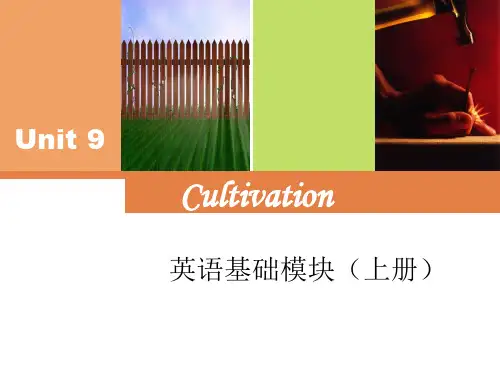
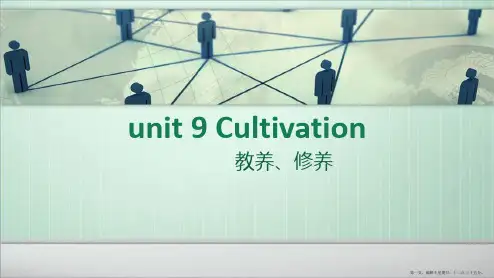

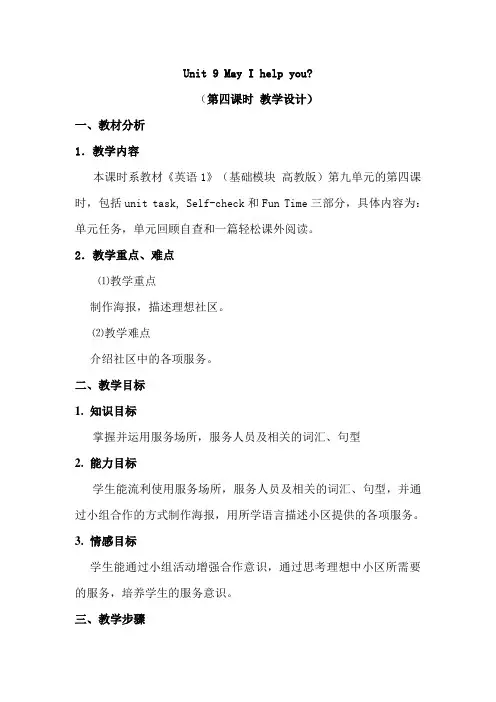
Unit 9 May I help you?(第四课时教学设计)一、教材分析1.教学内容本课时系教材《英语1》(基础模块高教版)第九单元的第四课时,包括unit task, Self-check和Fun Time三部分,具体内容为:单元任务,单元回顾自查和一篇轻松课外阅读。
2.教学重点、难点⑴教学重点制作海报,描述理想社区。
⑵教学难点介绍社区中的各项服务。
二、教学目标1.知识目标掌握并运用服务场所,服务人员及相关的词汇、句型2.能力目标学生能流利使用服务场所,服务人员及相关的词汇、句型,并通过小组合作的方式制作海报,用所学语言描述小区提供的各项服务。
3.情感目标学生能通过小组活动增强合作意识,通过思考理想中小区所需要的服务,培养学生的服务意识。
三、教学步骤Step One Lead-in1. Make a comment on the students’ homework. Read some good dialogues made by the students.(设计意图:作业点评是学生最喜欢的环节之一,值得教师长期坚持。
)2. Review the vocabularies and sentences about services. (设计意图:复习单元重点,为下面的海报制作环节打基础。
)Step Two Unit Task1.The teacher makes a questionnaire:Which community do you live?Is it convenient to live there?What services can you get in your community?What services do you wish you could get in your community? (设计意图:通过问卷调查,让学生观察并审视自己和同学们所住社区以及社区所提供的服务,使学生重视自己的生活环境,并且了解到社区服务的重要性,为下一步运用语言作背景知识的铺垫。
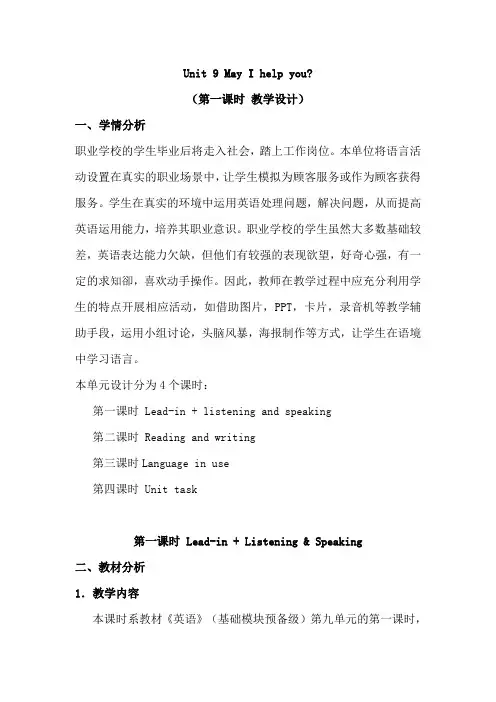
Unit 9 May I help you?(第一课时教学设计)一、学情分析职业学校的学生毕业后将走入社会,踏上工作岗位。
本单位将语言活动设置在真实的职业场景中,让学生模拟为顾客服务或作为顾客获得服务。
学生在真实的环境中运用英语处理问题,解决问题,从而提高英语运用能力,培养其职业意识。
职业学校的学生虽然大多数基础较差,英语表达能力欠缺,但他们有较强的表现欲望,好奇心强,有一定的求知卻,喜欢动手操作。
因此,教师在教学过程中应充分利用学生的特点开展相应活动,如借助图片,PPT,卡片,录音机等教学辅助手段,运用小组讨论,头脑风暴,海报制作等方式,让学生在语境中学习语言。
本单元设计分为4个课时:第一课时 Lead-in + listening and speaking第二课时 Reading and writing第三课时Language in use第四课时 Unit task第一课时 Lead-in + Listening & Speaking二、教材分析1.教学内容本课时系教材《英语》(基础模块预备级)第九单元的第一课时,包括Lead-in & Listening and speaking两部分,具体内容为:用英语在不同场合提供或获得服务,听懂并掌握提供或获得服务的词汇、句型。
2.教学重点、难点⑴教学重点用英语在不同场合提供或获得服务,听懂并掌握相关词汇、句型⑵教学难点服务场所名称词汇;提供或获得服务及其回答的词汇、句型三、教学目标1.知识目标⑴掌握服务场所名称及服务相关词汇,如hospital; bank;restaurant; airport; customer; patient; headache; pizza;department; vegetable salad; beef steak⑵学生能够掌握如何用英语在不同场合提供或获得服务,并做相应的回答,如:Would you like…?I’d like….How about…?2.能力目标⑴学生能听懂关于提供或获得服务的对话。
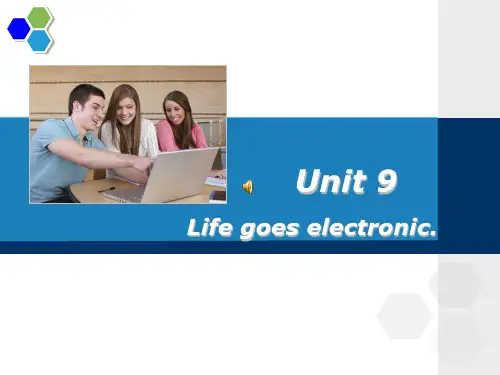
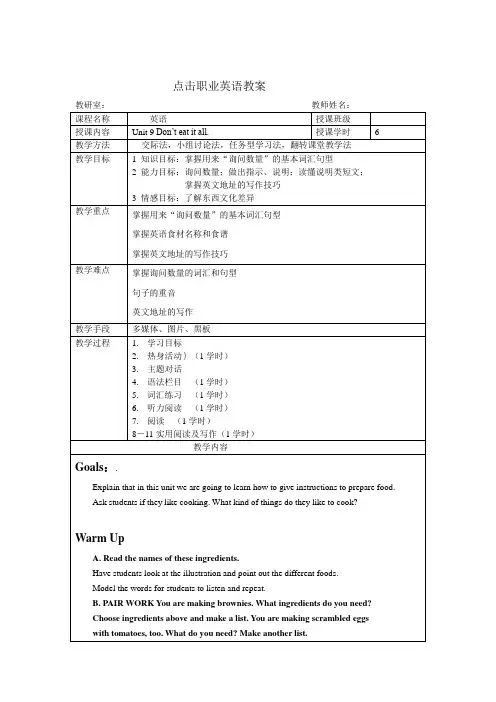
点击职业英语教案教研室:教师姓名:A. Read the conversation on page 118. Underline the imperatives.Have students work individually and underline all the affirmative and negative imperative forms in the conversation.Answer key: melt some chocolate and buttermix the sugar and eggs;add the chocolatedon’t eat it alltaste itadd the flour and baking powderput it in a panB. PAIR WORK Look at the pictures. Take turns.Give your partner cooking instructions.On the board put the verbs from Exercise B in one column and thefollowing ingredients in another: sugar and eggs; water; vegetables;scrambled eggs with tomatoes; bread; chocolate and butter.Then elicit which cooking verbs match each ingredient.Answer key:slice = vegetables, bread;melt = chocolate, butter;stir-fry = vegetables, meat, fish;pour = water;mix = sugar, eggs, chocolate, butter;boil = water, spaghettiAsking about quantity and numberWrite a list of countable and uncountable nouns on the board and the categories countable and uncountable. For example: milk, eggs, potatoes, coffee, sugar, flour, hamburgers, apples.Ask students to decide which type of noun each word is and to write it under the appropriate category.WORD BANKa kilo of 200 grams of a bag ofa pint of a liter of a gallon ofVocabulary in ContextCommenting on smell, taste, and lookReinforce the vocabulary by asking students what flowers or perfumes smell good to themand what foods taste good.homemade = something you make; you don’t buy it.A. Complete the sentences. Use look, smell, or taste.Have students work individually to complete the dialogs using forms of look, smell, or taste, and then have them check their work with a partner. Remind them to use singular or plural forms. Ask students if they think Casey and Stacey are being honest with Jason. Have them saywhy or why not. Elicit that they don’t say the brownies are homemade, but when Jason indicates that he thinks they are, they don’t correct him. Ask students to debate whethe r ornot that is being truthful, or to give their opinions about this situation.Answer key: 1. Look, looks, smells, tastes2. smell, taste, tastesB. GROUP WORK Practice the conversations above.Organize students into groups of three and have them take turns reading the different parts in the dialog aloud.The descriptive words in the box.Listening in ContextA. Ken is at Jason’s party. He is talking to Ben and Annie. He is planning a trip. Listen.Circle the cities on the map below as you hear them.Have students look at the map. Ask students if they know which of the foods in the photos (cheesecake, an apple, pizza, sourdough bread, lobster, coffee) are associated with which city (ies) on the map.Answer key: San Francisco, Seattle, Chicago, New York City, BostonB. Listen again. Look at the map. Match the food with the cities.Have students match the foods with the cities they think they go with by writing the letter of the photo next to the appropriate city.Answer key:pizza—Chicago, New Yorkapples—Seattlecheesecake—New York Citybread—San Franciscolobster—Bostoncoffee—SeattleReadingRecipes for great cooksBefore you readA. GROUP WORK Discuss. Can you cook? Do you like to cook? What do you cook?Ask each group who in their group likes to cook and what kind of dishes they like to prepare.While you readB. Read the recipe. Then put the ingredients in order.Tell students they are going to read Phil’s recipe for homemade fried rice and they need to number the ingredients in the order Phil uses them. As an example, have them read thefirst sentence and ask them which ingredient from the list comes first.After you readC. GROUP WORK Discuss. How much time does it take to make the fried rice?Write the answer on the recipe card. How many people does the recipe serve?Does this recipe look good? Is it an easy recipe?Answer key: 5–6 minutes once everything is all chopped upand ready to cook; 4–6 people.6. Best wishes7. Busy at work + visit from parents8. Meet at 3 pm on Saturday at Starbucks and visitnew bookshopPractical Writing: AddressesA. Complete the following table with the words from the box.Having studied section 9, students should be able to make an attempt at this exercise.B. Pair WorkAsk students to think of different scenarios. Writing to a friend or member of their family could be one. What if they were applying for a job and were asked to handwrite a letter? What if they were working for a company and had to reply to a complaint or ask for information? What other scenarios could they think of?The purpose here is to let students think about what would be appropriate language in different circumstances.Putting It TogetherGROUP WORK List food under each category.Have students look at the chart and make sure they understand the food categories byasking them for examples of each.Organize students into groups of three or four and tell them to list different examples under each food group.Write the categories on the board and invite volunteers from each group to add examples to。
